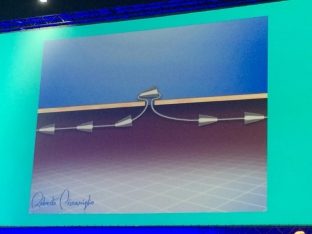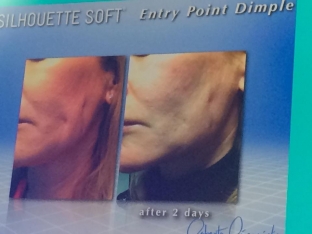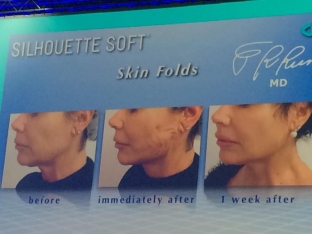In his report, Professor R. Pizzamiglio , a brilliant cosmetic surgeon, Associate Professor in Plastic Surgery at the University of Udine and Master of Cosmetic Surgery at the University of Padua, who teaches the Silhouette Lift procedure, paid special attention to the complications that can occur when working with Silhoette soft threads, and focused the attention of doctors on protocols for the treatment of these complications.

Complications when working with threads may be related to:
- with thread break;
- with changes in patient tissues;
- with infection.
- Let's consider the listed complications in more detail.
Possible breakage of the thread when injected under the skin
This is a fairly rare but very annoying complication when working with threads. It can be associated with two factors:
- The thread itself is broken. Thread breakage may be due to non-compliance with the temperature regime for storing threads.
Recommended:
- store threads according to instructions;
- Threads must not be inserted if patients have had multiple fillers in the insertion zone and intradermally there are fibrous bands. It is these obstacles that can cause the thread to pass more difficultly and, if the tension is strong, cause the thread to break.

- Risk of thread breakage when inserting the last cone. When working with threads, special attention should be paid to the moment of introduction of the last cone. If this cone is not correctly guided, it can become stuck on the surface and, if overtightened, cause injury to the insertion point and break the thread.
The reason for this situation is that the diameter of the base of the cone can be larger than the diameter of the inlet. The correct insertion in this case will depend on the angle of insertion of the last cone. It must enter the inlet vertically and, after insertion into the skin, make a horizontal turn.
Recommended:
- immediately before insertion of the last cone, lift it at the base with an additional needle and reposition the cone to a vertical position for easier insertion. Additionally, with the free hand, you need to increase traction during insertion. This will ensure a positive result of the thread insertion and protect the thread from breaking.
- Thread break when entangled. This is the rarest type of complication, but it occurs, and we should talk about the causes of its occurrence and how to solve this situation.
When we encountered this complication for the first time, we could not understand what caused it. I remind you that there are knots in the thread between the cones. Before starting work, you need to take the thread and stretch it in different directions. On the one hand, this tightens loose knots, on the other hand, it convinces us of the integrity of the thread with which to work.
Complications when working with threads associated with thread entanglement occurs due to the fact that the doctor forgot to tighten the knots, and the cones of the thread fell into the loop of the knot of the thread itself.
Recommended:
- before starting work, stretch the thread in a horizontal direction, tighten the knots and make sure the quality of the thread with which you will work.
Complications associated with changes in patient tissues
- Pole at the point of insertion of the thread. This is a fairly common complication when working with threads that we have to deal with. The cause of this complication is the wrong angle of insertion of the needle. Also, such a complication can occur with an incorrect assessment of the depth of the subcutaneous fat layer. In Asian patients, this layer will be very well developed, in contrast to Caucasian patients with their more elastic and thin skin.
Recommended:
- taking into account these features of the skin structure, insert the thread deeper in patients with a pronounced subcutaneous fat layer.
To prevent this complication, the first needle we use to make an entrance hole must be inserted exactly perpendicular to the skin. And the needle with the thread must be inserted in the same way, until the black mark on the needle passes, and only then do the needle turn.
If this complication occurs, you must wait 1 week, and if visual changes are not observed, you can insert a needle into this place and try to straighten the thread or cut it.

- Skin folds that occur after insertion. Skin folds will occur when we overcorrect the area we are working with. This can be viewed in two ways. On the one hand, this is exactly the result we are striving for, on the other hand, this is the result of the doctor's overly enthusiastic work.
Recommended:
- before the procedure, explain to the patient everything about possible changes. If our patient is patient, then in 1-2 weeks the skin will find its balance and straighten itself out. The result will be very good. In extreme cases, you can make a slight correction with hyaluronic acid preparations.
If the patient is not ready for such changes, do not overcorrect. A slight lift will give you a good aesthetic result.

Complications associated with infection after thread insertion
- Complications associated with infection of the skin and improper processing of the skin. It is necessary to be very careful in the selection of patients and a serious collection of anamnesis. Under no circumstances should patients with pustular lesions of the skin be taken.
Recommended:
- Take your history carefully! It is especially important to identify patients with diabetes mellitus, autoimmune diseases and patients with a tendency to form keloid scars.
After the procedure, apply an antibacterial cream at the needle entry and exit points.
- Complications associated with hair ingestion. When working with threads, we often make corrections when the thread entry points are in the temporal region. It is this area that will give a good lifting effect for the entire face. And it is here that we may encounter a complication in the form of the introduction of a hair that can catch on a knot or cone of thread.
Recommended:
- observe the rules of the surgical field and monitor the correct placement of the thread in this area.







Add a comment